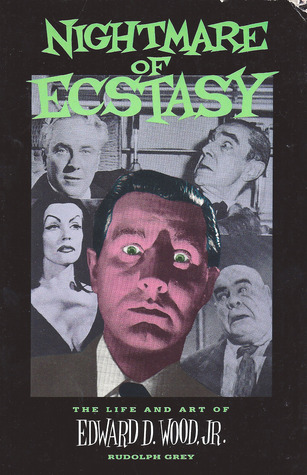By RUDOLPH GREY (Feral House; 1992)
Back in 1992, when this book first appeared, there was very little concrete information about Edward D. Wood, Jr., the so-called Worst Director of all Time. Thus, NIGHTMARE OF ECSTASY seemed a most welcome appetizer to a main course I was certain wasn’t far behind. This is to say that this 231 page book isn’t all it could be, reading more like an extended outline than a proper biography. Thus it’s all the more vexing that, in a twist of fate that could have been conceived by Ed Wood himself, NIGHTMARE OF ECSTASY is now considered the major reference point for Wood fanatics, and the basis for Tim Burton’s acclaimed 1994 biopic.
NIGHTMARE OF ECSTASY is now considered the major reference point for Wood fanatics
The book takes the form of an oral history, made up entirely of quotes from people who knew Mr. Wood. Most of the facts of his existence are covered (though never in much depth), from his upbringing in 1940s era Poughkeepsie, NY, where his mother liked to dress him in girl’s clothing, to his stint in the Marines during WWII, in which he claimed to have worn bras and panties under his uniform. Upon being discharged Wood joined a traveling circus before settling in Hollywood, where he immersed himself in the exploitation film making scene.
The book takes the form of an oral history, made up entirely of quotes from people who knew Mr. Wood.
He became known for his irrepressible skirt-chasing (with the angora sweaters owned by his conquests having a tendency to end up in his closet) and charity toward an aging Bela Lugosi, who Wood cast in several of his grade-Z epics (such as GLEN OR GLENDA and BRIDE OF THE MONSTER). Each is discussed here, in sections that generally last a page of two, with the most coverage given over to the film Wood regarded as his magnum opus (and which much of the rest of the world regards as the worst movie ever made): PLAN 9 FROM OUTER SPACE (1959).
Things went downhill quite dramatically in the 1960s and 70s, when Wood’s alcoholism got the better of him. Reduced to writing smut novels to pay the bills, he gave away most of the memorabilia he owned and fell prey to despair and spousal abuse. His final days, as recorded here, were downright nightmarish, with he getting evicted from his crime-ridden Hollywood apartment and losing most of his remaining possessions, including his war medals and a biographical novel he was writing about Lugosi. He died on December 10, 1978 at age 54, due to what could have been any number of factors.
Things went downhill quite dramatically in the 1960s and 70s, when Wood’s alcoholism got the better of him.
As is often the case with oral biographies, the quotes contained in this book, from a retinue that includes producer Samuel Arkoff, trash movie legend Aldo Ray, Wood’s widow Kathy and the man himself, tend to be quite contradictory. A description of Bela Lugosi as a consummate gentleman, for instance, is followed by a remembrance of him shouting “fuck you!” in a public place, while Wood himself comes off as, by turns, sweet-natured, petty, charitable and self-absorbed.
But seeing as how beggars can’t be choosers, it looks like we’ll have to make peace with NIGHTMARE OF ECSTASY’S shortcomings. It admittedly does its job quite adequately, filling us in on the major events of Ed Wood’s life and career, and the many odd people who orbited him. The book also deserves credit for containing what might be the most thorough bibliography of Wood’s written works in existence (several titles are left off, but in truth no fully comprehensive such listing is possible). So in summation, this book is not a bad choice for the definitive Ed Wood resource. I just can’t help but wish there were a bit more to it.

